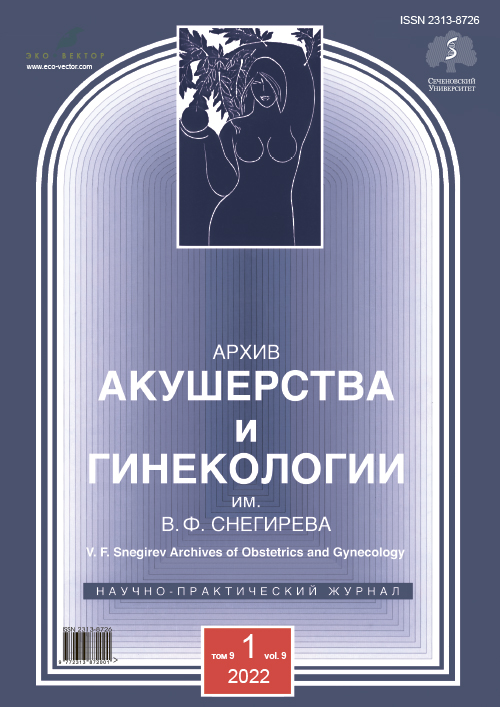Анализ эффективности выбора оптимального метода хирургического лечения пролапса гениталий
- Авторы: Мусин И.И.1, Ящук А.Г.1, Урманцев М.Ф.1, Берг Э.А.1, Молоканова А.Р.1, Берг П.А.1
-
Учреждения:
- Башкирский государственный медицинский университет
- Выпуск: Том 9, № 1 (2022)
- Страницы: 49-55
- Раздел: Оригинальные исследования
- Статья получена: 17.02.2022
- Статья одобрена: 17.02.2022
- Статья опубликована: 15.01.2022
- URL: https://archivog.com/2313-8726/article/view/100983
- DOI: https://doi.org/10.17816/2313-8726-2022-9-1-49-55
- ID: 100983
Цитировать
Полный текст
Аннотация
Цель исследования ― оценка эффективности выбора метода хирургического лечения пролапса гениталий в зависимости от интенсивности перфузии тканей тазового дна.
Материалы и методы. В данной статье проведена оценка взаимосвязи экстрагенитальной патологии, данных анамнеза у оперированных по поводу пролапса гениталий пациенток и у женщин без пролапса гениталий в период пери- и постменопаузы (группа контроля, n=67) с показателями интенсивности перфузии влагалища. Прооперировано 328 пациенток с пролапсом тазовых органов II―IV степени по системе POP-Q, из которых 287 пациенток осмотрели через 2 года для диагностики рецидива заболевания; этих пациенток включили в основную группу исследования (n=287). Для статистической обработки полученных результатов применили пакет программ STATISTICA 10.0 и EViews 12.0.
Результаты. Корреляционный анализ позволил выявить обратную взаимосвязь интенсивности микроциркуляции влагалища с возрастом женщин (rs=−0,187; р=0,025), длительностью менопаузы (rs=−0,390; р=0,001), длительностью заболевания пролапсом гениталий (rs=−0,245; р=0,046) и хирургической менопаузы (rs=−0,442; р <0,001).
Изучение показателей интенсивности микроциркуляции передней и задней стенки влагалища в зависимости от наличия соматических заболеваний выявило обратную корреляционную взаимосвязь с такими заболеваниями, как гипертоническая болезнь (rs=−0,291; р <0,001), ишемическая болезнь сердца (rs=−0,169; р=0,044) и сахарный диабет (rs=−0,223; р=0,008). При выборе метода хирургического лечения, минимизирующего контакт сетчатого протеза с нативными тканями у женщин с коморбидной патологией, рецидив заболевания через 2 года выявлен всего у 2,4% женщин.
Заключение. Выбор оптимального метода лечения у пациенток с соматической отягощённостью и низкой перфузионной способностью органов и тканей малого таза позволяет снизить количество осложнений после хирургического лечения тазового пролапса.
Ключевые слова
Полный текст
Об авторах
Ильнур Ирекович Мусин
Башкирский государственный медицинский университет
Автор, ответственный за переписку.
Email: ilnur-musin@yandex.ru
ORCID iD: 0000-0001-5520-5845
к.м.н., доцент кафедры акушерства и гинекологии
Россия, 450112, Уфа, ул. Ленина, д. 3, Республика БашкортостанАльфия Галимовна Ящук
Башкирский государственный медицинский университет
Email: ilnur-musin@yandex.ru
ORCID iD: 0000-0003-2645-1662
д.м.н., профессор, зав. кафедрой акушерства и гинекологии
Россия, 450112, Уфа, ул. Ленина, д. 3, Республика БашкортостанМарат Фаязович Урманцев
Башкирский государственный медицинский университет
Email: urmantsev85@mail.ru
ORCID iD: 0000-0002-4657-6625
к.м.н., доцент, зав. отделением онкологии
Россия, 450112, Уфа, ул. Ленина, д. 3, Республика БашкортостанЭдвард Александрович Берг
Башкирский государственный медицинский университет
Email: aig.eaberg@gmail.com
ORCID iD: 0000-0002-2028-7796
ассистент кафедры акушерства и гинекологии
Россия, 450112, Уфа, ул. Ленина, д. 3, Республика БашкортостанАнжелла Радиковна Молоканова
Башкирский государственный медицинский университет
Email: ilnur-musin@yandex.ru
ORCID iD: 0000-0003-1115-6775
аспирант
Россия, 450112, Уфа, ул. Ленина, д. 3, Республика БашкортостанПолина Андреевна Берг
Башкирский государственный медицинский университет
Email: kovalenko.polina93@yandex.ru
ассистент кафедры акушерства и гинекологии
Россия, 450112, Уфа, ул. Ленина, д. 3, Республика БашкортостанСписок литературы
- Буянова С.Н., Щукина Н.А., Дуб Н.В., Чечнева М.А., Земскова Н.Ю. Клиника, диагностика и лечение сложных и смешанных форм недержания мочи у женщин. Москва : АдамантЪ, 2012.
- Ищенко А.А., Ищенко А.И., Александров Л.С., Гилядова А.В. Возможности проведения хирургических вмешательств, направленных на коррекцию опущения органов малого таза, в условиях гинекологического отделения городского родильного дома // Архив акушерства и гинекологии им. В.Ф. Снегирёва. 2018. Т. 5, № 2. С. 83–87. doi: 10.18821/2313-8726-2018-5-2-83-87
- Isık H., Aynıoglu O., Sahbaz A., et al. Are hypertension and diabetes mellitus risk factors for pelvic organ prolapse? // Eur J Obstet Gynecol Reprod Biol. 2016. Vol. 197. P. 59–62. doi: 10.1016/j.ejogrb.2015.11.035
- Kerkhof M.H., Hendriks L., Brölmann H.A.M. Changes in connective tissue in patients with pelvic organ prolapse ― a review of the current literature // Int Urogynecol J Pelvic Floor Dysfunct. 2009. Vol. 20, N 4. P. 461–474. doi: 10.1007/s00192-008-0737-1
- Cooper J., Annappa M., Dracocardos D., et al. Prevalence of genital prolapse symptoms in primary care: a cross-sectional survey // Int Urogynecol J. 2014. Vol. 26, N 4. P. 505–510. doi: 10.1007/s00192-014-2556-x
- Cao Q., Chen Y.S., Ding J.X., et al. Long-term treatment outcomes of transvaginal mesh surgery versus anterior-posterior colporrhaphy for pelvic organ prolapse // Aust N Z J Obstet Gynaecol. 2013. Vol. 53, N 1. P. 79+85. doi: 10.1111/ajo.12040
- Weber M.A., Milstein D.M., Ince C., Roovers J.P. Is pelvic organ prolapse associated with altered microcirculation of the vaginal wall? // Neurourol Urodyn. 2016. Vol. 35, N 7. P. 764–770. doi: 10.1002/nau.22805
- Vashaghian M., Zaat S.J., Smit T.H., Roovers J.P. Biomimetic implants for pelvic floor repair // Neurourol Urodyn. 2018. Vol. 37, N 2. P. 566–580. doi: 10.1002/nau.23367
- Swenson C.W., Simmen A.M., Berger M.B., Morgan D.M., DeLancey J.O. The long and short of it: anterior vaginal wall length before and after anterior repair // Int Urogynecol J. 2015. Vol. 26, N 7. P. 1035–1039. doi: 10.1007/s00192-015-2636-6
- Maher C., Baessler K., Glazener C.M., Adams E.J., Hagen S. Surgical management of pelvic organ prolapse in women // Cochrane Database Syst Rev. 2004. N 4. P. CD004014. doi: 10.1002/14651858.CD004014.pub2
Дополнительные файлы







